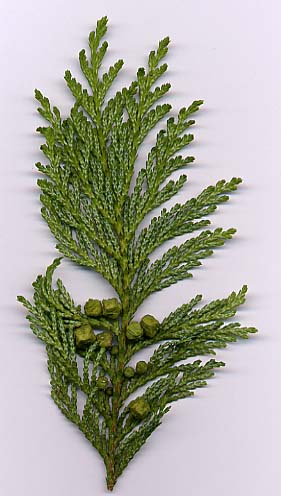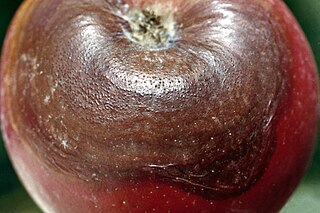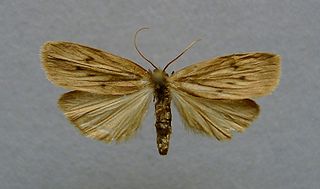
Chamaecyparis, common names cypress or false cypress, is a genus of conifers in the cypress family Cupressaceae, native to eastern Asia and to the western and eastern margins of the United States. The name is derived from the Greek khamai (χαμαί), meaning "on the earth", and kuparissos (κυπάρισσος) for "cypress".

Chamaecyparis obtusa is a species of cypress native to central Japan in East Asia, and widely cultivated in the temperate northern hemisphere for its high-quality timber and ornamental qualities, with many cultivars commercially available.

Botryosphaeria obtusa is a plant pathogen that causes frogeye leaf spot, black rot and cankers on many plant species. On the leaf it is referred to as frogeye leaf spot; this phase typically affects tree and shrubs. In fruit such as the apple, cranberry and quince, it is referred to as black rot, and in twigs and trunks it causes cankers.

The broad-tailed paradise whydah is a species of bird in the family Viduidae. It is found in woodland and acacia savanna habitat in Sub-Saharan Africa from Angola to Uganda, Tanzania and Mozambique. A brood parasite, it has a wide range and the International Union for Conservation of Nature has assessed it as being of least concern.
Shorea obtusa, the Siamese sal, is a species of hardwood tree in the family Dipterocarpaceae, native to Southeast Asia.

Plumeria obtusa, the Singapore graveyard flower, is a species of the genus Plumeria (Apocynaceae). It is native to the Neotropics, but widely cultivated for its ornamental and fragrant flowers around the world, where suitably warm climate exists.

Chamaecyparis taiwanensis is a species of cypress, native to the mountains of Taiwan, where it grows at altitudes of 1300–2800 m.

Pelosia obtusa, the small dotted footman, is a moth of the family Erebidae. The species was first described by Gottlieb August Wilhelm Herrich-Schäffer in 1847. It is found from central Europe through Asia to the Pacific Ocean.

Hemilophini is a tribe of longhorn beetles of the subfamily Lamiinae.
Tyrinthia is a genus of longhorn beetles of the subfamily Lamiinae, containing the following species:
Tyrinthia dionae is a species of beetle in the family Cerambycidae. It was described by Martins and Galileo in 2004. It is known from Colombia.
Tyrinthia moroiuba is a species of beetle in the family Cerambycidae. It was described by Martins and Galileo in 1991. It is known from Colombia and Costa Rica.
Tyrinthia turuna is a species of beetle in the family Cerambycidae. It was described by Martins and Galileo in 1993. It is known from Colombia.
Tyrinthia colombiana is a species of beetle in the family Cerambycidae. It was described by Galileo and Martins in 2009. It is known from Colombia.
Tyrinthia capillata is a species of beetle in the family Cerambycidae. It was described by Henry Walter Bates in 1866. It is known from Bolivia, Peru and Brazil.
Tyrinthia lycinella is a species of beetle in the family Cerambycidae. It was described by Henry Walter Bates in 1881. It is known from Costa Rica and Honduras.
Tyrinthia photurina is a species of beetle in the family Cerambycidae. It was described by Henry Walter Bates in 1885. It is known from Panama.
Tyrinthia scissifrons is a species of beetle in the family Cerambycidae. It was described by Henry Walter Bates in 1866. It is known from French Guiana, Brazil and Trinidad.
Tyrinthia xanthe is a species of beetle in the family Cerambycidae. It was described by Henry Walter Bates in 1881. It is known from Costa Rica, Panama and Nicaragua.
Tyrinthia klugii is a species of beetle in the family Cerambycidae. It was described by James Thomson in 1868. It is known from Colombia.







